#oberbaumbrücke
Text

Oberbaumbrücke, Bridge, Berlin, Germany: The Oberbaum Bridge is a double-deck bridge crossing Berlin, Germany's River Spree, considered one of the city's landmarks. It links Friedrichshain and Kreuzberg, former boroughs that were divided by the Berlin Wall, and has become an important symbol of Berlin's unity. Wikipedia
70 notes
·
View notes
Text

Oberbaumbrücke
Berlin, Germany
#photographers on tumblr#architecture#oberbaumbrücke#bridges#berlin#germany#fernsehturm#cities#rivers#spree#boats#original photographers#original photography
69 notes
·
View notes
Photo




La flor / The Flower
Mariano Llinás. 2018
Bridge
Oberbaumbrücke, 10243 Berlin, Germany
See in map
See in imdb
Bonus: also in this location
#mariano llinás#la flor#the flower#pilar gamboa#oberbaumbrücke#berlin#kreuzberg#friedrichshain#bridge#germany#movie#cinema#film#location#google maps#street view#2018#bonus
10 notes
·
View notes
Text

#nikon#original photographers#Berlin#photographers on tumblr#beginner photographer#photography#original photography blog#travel#travel photography#tourist#traveling#germany#cityscape#travel destinations#oberbaumbrücke#streetsign#CityPhotography#BerlinExploration
3 notes
·
View notes
Text



8 notes
·
View notes
Text




Piedra, papel, tijera.
(Rock, paper, scissors)
En la estructura de acero del terraplén del Metro en el puente Oberbaumbrücke hay instaladas dos cajas luminosas, en las que de noche se proyecta el juego “piedra, papel o tijera”. Un generador aleatorio controla tres tubos fluorescentes de varios colores.
Es una obra de Thorsten Goldberg.
4 notes
·
View notes
Text

Berlin, Oberbaumbrücke.
#espritmetropol#photographers on tumblr#photography by espritmetropol#original photographers#espritmetropolphotography#berlin#espritnouveauphotography#street photography#artists on tumblr#espritmetropol-photography#oberbaumbrücke#2022
11 notes
·
View notes
Text
Connecting bridge
We left the touristy part of the Spree behind us, the tourist boats all turn around in front of the lock at Mühlendamm. We enjoyed the view of what I assume is an artists’ collective, river-side coffee houses and interesting architecture.
We had previously turned left off the Spree onto the Landwehrkanal. At the Spreekreutz, where four waterways meet, we turned right to be back on the Spree…

View On WordPress
0 notes
Text
Saturday 11 July 1998 - First time across the Oberbaumbrücke into East Berlin - Alexanderplatz and the world clock - Love Parade from 2 PM to 9 PM - supper at Escados and a long S-Bahn ride home to Nikolassee
11 July 1998 Love Parade in Berlin
Hi everybody,
Today 20 years ago, is part two of three, of the weekend in Berlin. It was also the day of the Love Parade 1998 - hence the hearts from my last post. It would not start until about 2 PM on Straße des 17 Juni, so I could get some sightseeing done before that and still take the U-Bahn.
The night was not too bad. My other roommates were not particularly noisy. The temperature was fair, about the low 50s by 7 AM. The showers were located in the hall.
My hostel had a breakfast room and breakfast was complimentary. It was the usual kind of breakfast at a typical Deutsches Jugendgästehaus, breads, cheese, butter, jam, hazelnut spread, sliced deli meats, orange juice, coffee and tea. I spent about half an hour. Then I went back to my room to get enough film for sightseeing. What I did not know was, I should have packed an extra camera battery. With the Samsung Evoca 115, it does not use conventional batteries. It uses a special U-Shaped battery about 5 volts called a "CR123". Will talk more about that for Sunday the 12th July. Then I walked the half mile to the Nikolassee train station but did not board a train, but a bus. This was because I wanted to go to Krumme Lanke along the U-1 into downtown and then take the S-Bahn from Heidelberger Platz to Innsbrucker Platz and take the U-4 to Nollendorfplatz. As for the Berlin U-Bahn map, please bear with me, as the lines have been reconfigured in the past twenty years that I last visited on my own, so I will likely mention the lines I remember from back then, rather than refer to the current line structure. As long as I still had the 72 hour pass, I did not need to worry about any "Fahrscheinkontrolle" that charged 80 D-Mark for not having a valid ticket.
I took a double decker bus from Nikolassee to the Krumme Lanke U-Bahn station and took the U-1 to Heidelberger Platz. The line ran at-grade up to Podbielskialle and went underground for two more stops. I had to come out of the tunnel for the S-41 that went to Innsbrucker Platz. The entire U-4 is still underground as it was in 1998. When the train arrived in Nollendorfplatz, there were two underground levels and one elevated one. That is what makes Nolledorfplatz unique. I went farther on the U-1 to Warschauer Straße, across the Spree by the Oberbaumbrücke. I believe I already mentioned, that up to 1995, the U-1 terminated only at Schlesisches Tor on the east, as that was where the wall was, and Warschauer Straße happened to be in the Soviet-controlled "East Zone". Many of the stations in the East Zone in 1998 appeared to be preserved as they existed in the Cold War, but have in the last twenty years been renovated, so if you happened to be born after 1989, you might not be able to recognize which stations were in the East Zone and which were in the Allied sectors. Allied being the USA, UK and France. It was a profound feeling to see the Warschauer Straße station, as it was cut off from the rest of the U-Bahn network for decades.
I had to walk across a pedestrian bridge at Warschauer Straße to be able to access the S-Bahn line. I wanted to see Alexanderplatz, the tower and the interesting world clock that must have 24 faces. The clock for many years did not have Tel Aviv or Jerusalem mentioned until that was changed in 1997, as it was GDR policy to not recognize the existence of Israel. I think The Bourne Supremacy had a scene in that particular square years later. I found a place where I might want to eat dinner, the Escados steak restaurant. They would be open until very late, I guess just before midnight, so I made a point to come back later that evening.
After seeing Alexanderplatz, I wanted to go back to West Berlin, and the Checkpoint Charlie museum. To get there from Alexanderplatz, I needed to take the U-2 to Stadtmitte and then south to Kochstraße by U-6. In the Cold War, the U-2 was an operating line on both sides of the wall. However the U-6 had several "ghost stations" that had just the lights dimly lit while the trains just passed through and did not reopen until after Reunification.
What luck, when I arrived at Kochstraße, the location of the iconic Checkpoint Charlie border crossing, the eponymous museum was open that day, so I decided to go inside for an hour or so. It was very interesting inside, with so much Cold War memorabilia. There was a Trabant that had a secret compartment to smuggle out people from East Germany to the West. And yes there was a controversial painting of Erich Honecker and Mikhail Gorbatchev, I will not go into any detail, you might look it up for yourself. As I had my passport with me, I paid 2.50 D-Mark to get a historical East Berlin border crossing stamp.
I think at Alexanderplatz, during the Cold War, that was one of the official border crossings for the U-Bahn and S-Bahn. One of the rules for entering East Berlin from West Berlin, was that you would have to change 25.00 D-Mark into 25 Ostmark. More information about the Ostmark at https://en.wikipedia.org/wiki/East_German_mark. And all the Ostmark was required to be spent before returning to the West. Because the cost of living in East Berlin as compared to West Berlin was so cheap, it made spending money difficult. One way to tell the Ostmark from the D-Mark, is that the Ostmark coins were made out of lighter metal than the D-Mark coins. There were also Intershops that accepted only hard currency and sold western wares. All I am aware of, is what my high school German teacher taught in class, and also other peoples' experiences.
After visiting the Checkpoint Charlie Museum, it was getting close to 1 PM. I stopped at a Kaiser Tengelmann store to buy food to make sandwiches, as I wanted to save money for a nice steak at Escados later. I love my Lyoner and Blutwurst so I bought some of that with slices of good looking white cheese, and some more soda cans. After that, I went on to Alexanderplatz, and then walked along Unter den Linden past the Berliner Dom and the then-standing Palast der Republik. The Palast der Republik was up to 1990, the parliament building for the East German government. Appearancewise, the Palast der Republik was made out of brownish copper and similarly tinted glass. It was a postwar brutalist style. People were gathering east of the Brandenburger Tor, as the Lovemobiles with the loud music were along Straße des 17 Juni.
So what is the Love Parade supposed to be? It was started in 1989 by DJ Dr Motte as a non-partisan political demonstration for peace and international understanding. And a great deal of electronic music which evolved from that of Kraftwerk. The Love Parade drew in later years up to 2003, about a million participants. To have a successful Love Parade, it is necessary to obtain funding and sponsors. In 2004 it was starting to be difficult to find sponsors and also the required permits in a timely manner. As for the music variety, I think there were 20 Lovemobiles in total, DJ Motte was at the head, there were others like DJ Marusha, Paul Van Dyk, Sven Väth, and Da Hool
Two of the drawbacks are, one of which, getting inadvertently dirty as a result of others drinking on the streets - glass was allowed as was aluminum and plastic, so it was necessary to watch one's step around areas where glass bottles were broken. There must have been an inch of garbage along the Straße des 17 Juni on average. I would not want to be part of the sanitation crew the next morning. Also, 11th July 1998 was one of the days that Germany had forgotten about its Mehrwegflasche recycling scheme - sad. The other drawback is if you do not have proper ear protection, you might have a horrible ringing of the ears. Foam earplugs were given out for free (someone donated for a bulk of them). Also during the Street Parade, the weather did not cooperate very well. Though it was in the upper 60s to lower 70s, there were periods of drizzle, alternating with periods of sunshine, and the DJs took special care to protect their equipment, so the music would last well into the late hours of about 10:30 or 11 PM.
The Love Parade was very large, in comparison to the little Marlboro cigarette garden parties from 1997 that I attended July 1997 in Hamburg and Munich, similar attire as the Love Parade, turnout of a thousand people each at most. Statistics show that there were 800,000 participants for 1998, so good turnout.
Recommended videos
Da Hool - Meet her at the Love Parade
https://www.youtube.com/watch?v=KO4y3nkJXDA
Dr Motte & Westbam - One world, one future (the theme for the 1998 Love Parade in Berlin)
https://www.youtube.com/watch?v=CDJ20spGymE
There have to be about a dozen Love Parade 1998 videos online, some lasting as long as six whole hours. I leave it to you to decide whether to watch those, especially if you are on a mobile data plan – be careful of how much bandwidth you use unless you’re on Wifi or ethernet.
I have to give the cleanup crew, security and first responders compliments on their professionalism. There was a little bit of humor when an ambulance was driving through the Straße des 17 Juni, and he said "Please clear the street. You know how to do that, right? We all went to school didn't we?". Then some silly person shouted "Not I! Not I!". Both exchanges were in German.
The next such parade I would attend would be the Street Parade, on 8th August 1998 in Zürich. That had a good turnout. I will tell more about it early next month.
I got tired about 10 PM and thought it was time for dinner. I had to walk past the Brandenburger Tor, along Unter den Linden to Alexanderplatz. Escados was still open for late dinner. I ordered a 5 ounce steak with chili and summer vegetables, and had a Berliner Kindl beer with it. It was a fairly relaxing dinnertime after a long afternoon and evening with loud electronic music. But it was fun nonetheless.
To return to the hostel, I should have taken the direct S-Bahn to Nikolassee, but I chose a different route. I took a line 100 bus to Rosenthaler Platz to catch the U-8. This was part of the U-8 Ghost Station line in East Berlin, up to Gesundbrunnen which was considered to be in West Berlin. Then I took the S-1 "the long way" back to Nikolassee. Somehow Ingo Ruff's voice put me to sleep until about Mexikoplatz. I made it back to the hostel about 11:45 PM and I went to sleep.
The next day I would have to check out and make my way home to Munich. I did not know about the Third Place match for FIFA 1998, but I later found out Croatia beat the Netherlands 2 to 1.
Tomorrow, Part 3, including Spandau and my impressions of Cold War Berlin’s U-Bahn line U-5.
Gute Nacht, bis morgen.
#Germany#Berlin#Deutschland#Kaisers Verbrauchermarkt#Jugendgästehaus am Wannsee#U1#Onkel Toms Hütte#Fehrbelliner Platz#Warschauer Straße#Oberbaumbrücke#Märkisches Museum#Krumme Lanke#Schlesisches Tor#Nollendorfplatz#Innsbrucker Platz#Alexanderplatz#Tel Aviv#Jerusalem#Bourne Supremacy#Checkpoint Charlie#Kochstraße#ghost station#Cold War#East Germany#GDR#DDR#Erich Honecker#East Berlin#Palast der Republik#Unter den Linden
0 notes
Video
Sitzen zwei Tauben aufm Pfeiler by Pascal Volk
#Europe#Germany#Berlin#Berlin Friedrichshain-Kreuzberg#Friedrichshain#F'hain#Menschen#People#Leute#Street Photography#Oberbaumbrücke#Oberbaum Bridge#Puente de Oberbaum#ARTinBW#schwarz#weiß#black#white#Black and White#schwarzweiß#S&W#B&W#bnw#blanco y negro#blanco-negro#Spring#Frühling#Primavera#Canon EOS 5D Mark IV#5DMkIV
1 note
·
View note
Photo




Oberbaumbrücke - Berlin
#berlin wall trail#mauerweg#berliner mauerweg#berlin#germany#architecture#bridge#photography#photographers on tumblr#2022#oberbaumbrücke
1 note
·
View note
Photo
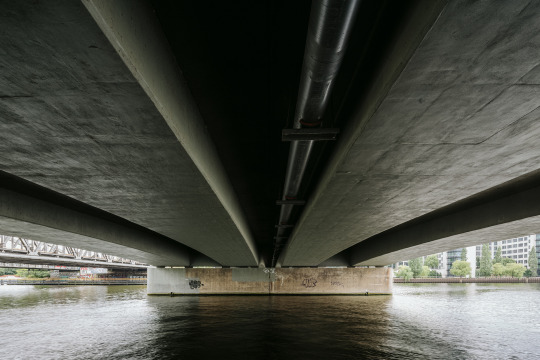



Berlin
Friedrichshain
Osthafen
Canon TS-E 17mm f/4L@Canon EOS 5D Mark III
#Canon EOS 5D Mark III#Canon TS-E 17mm f/4L#germany#Deutschland#Berlin#Friedrichshain#Osthafen#Elsenbrücke#Treptowers#nhow#Oberbaumbrücke#architecture#Architektur#Spree#river#Fluss#water#Wasser#urban#modern#city#retro#vintage#colors#colours#Farben
1 note
·
View note
Text
Modenschau auf stählernen Achsen
Eine Schar Tauben begleitet spielend eine U-Bahn, die im blendenden Licht der Morgensonne mühsam von Süden auf die Oberbaumbrücke rollt. Während der Zug langsam voranschreitet, blitzt der dottergelbe Lack an den Ecken und Rundungen der Waggons immer wieder hell auf. Es gibt dunkelgelbe und zitronengelbe U-Bahnen in Berlin, stöhnende und summende, kantige und kurvige, Glastüren tragende und aus beuligem Blech geschweißte, manche haben Scheinwerfer wie Kulleraugen und wieder andere, moderne, blicken durch große Frontscheiben wie Agenten durch ihre Sonnenbrillen. Alle zeigen sie kurz ihr Gesicht, während sie in der ziegelgedeckten Station Schlesisches Tor ihren Fahrgästen freien Lauf lassen. Durch eine Baumschlucht hindurch, unter das Haltestellendach geduckt, nehmen sie für einen Moment Ausguck über die sich quer vor ihnen ausbreitende sanft strömende Spree und auf die spiegelnden Hochhäuser drüben an der Warschauer Straße. Die Türen schließen. Hinaus geht es auf den stahlgenieteten Laufsteg. Die Waggonkette verschwindet hinter graffitiverzierten Hausfassaden wie hinter einem Vorhang, dann präsentiert sich der ungewöhnliche Aufzug in dem weiten Gleisbogen vor der Brücke in seiner ganzen gelben Schönheit. Und jetzt, nach einer weiteren Biegung, diesmal nach links, stolzieren die Waggons in einer eleganten Reihe auf die Oberbaumbrücke, spielen mit den rot-schwarz geklinkerten Zinnen, bereiten die Spitzbögen, ordnen sich unter die keck salutierenden Türme, passieren mutig das kurzweilig geschwungene eiserne Mittelstück, vollziehen von Fußgängern, Autos und Radfahrerinnen beachtet oder auch nicht beachtet den Höhepunkt der Schau. Sie rollen behutsam weiter, ihre Flanken liegen im Schatten, gleiten klingend von der schmuckvoll gemauerten Wasserbühne. Beinahe im Minutentakt werden hier Kunststücke aufgeführt, surrend wie die ganze große Stadt.
#U-Bahn#Berlin#Oberbaumbrücke#Morgensonne#Spree#Modenschau#Laufsteg#Bühne#Wasser#Schlesisches Tor#Warschauer Straße
1 note
·
View note
Text
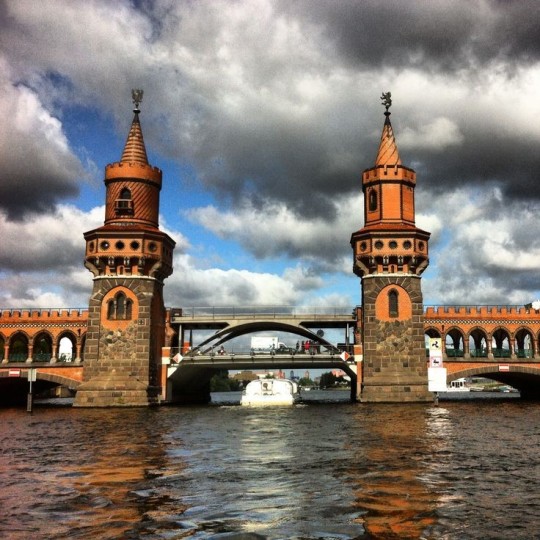
Oberbaumbrücke | Pinterest @di030
1 note
·
View note
Text



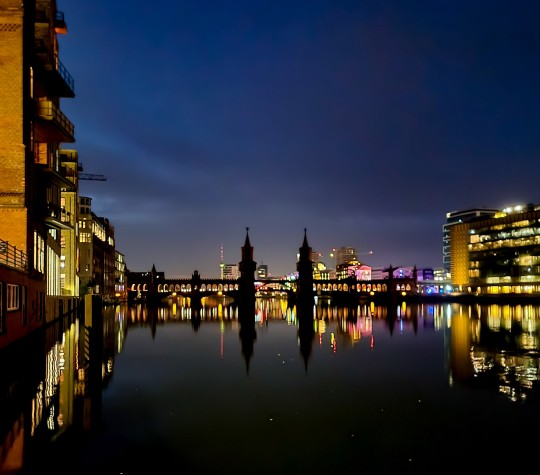
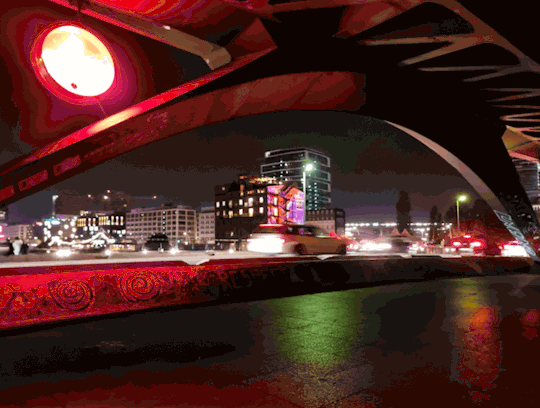

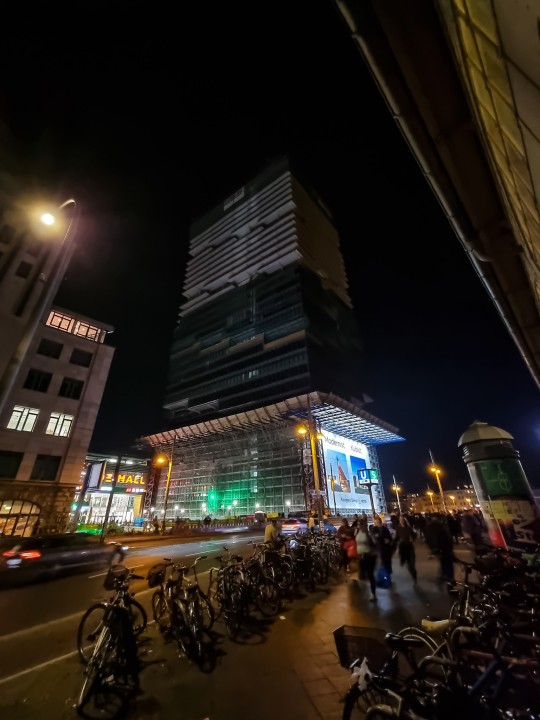
24 notes
·
View notes
Photo

No filter no photoshop just lucky with the evening light #berlin #oberbaumbrücke https://www.instagram.com/p/CoXlRv9sM83/?igshid=NGJjMDIxMWI=
0 notes